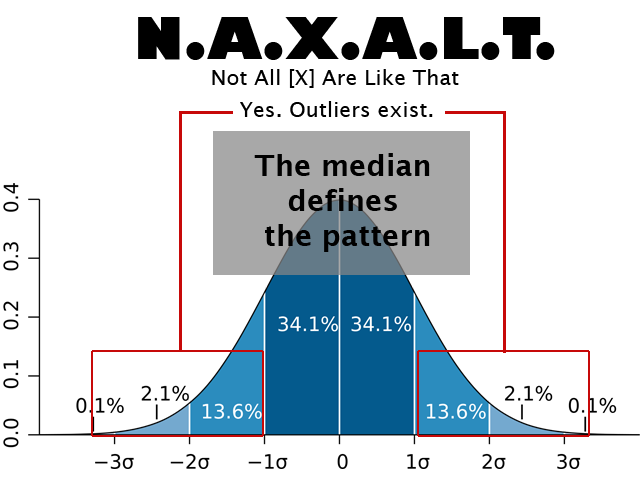Video Transcript
NAXALT stands for “Not All X Are Like That”.
In any discussion of group patterns, someone will inevitably use the NAXALT fallacy, as though it is a meaningful rebuttal. When discussing group patterns, it is not.
For example, if we are discussing swans, someone will say “Swans are white”, which will elicit the rebuttal “But, there are black swans too.” This is NASALT: Not All Swans Are Like That.
The problem is that when we say “Swans are white”, this can be interpreted as “Swans are universally white” or “Swans are generally white.” “Swans are white” is a generalization, not a universalization. We use generalizations a lot in our daily lives, and we just assume that we are talking about the general and not the universal. I might say “The Dutch are tall.” Obviously, the Dutch are not universally tall, even without visiting Holland, we know that there are some Dutch who are shorter than others. We naturally assume that we are talking about the general. When we say “The Dutch are tall,” it’s just sort of obvious that we mean generally.
Generally, swans are white, so: “Swans are white.”
Humans are pattern matching machines. We don’t need to take a survey and produce a statistical graph to know that “Swans are white.”
However, there are more controversial and complex topics where we do rely on statistical data.
This is a “Bell Curve”.
In statistics we call this a “normal distribution.” Many human traits, such as height, weight, or IQ, when measured in a large group of individuals, will take the form of a bell curve. The middle of the bell is the median. This is the norm. The tails on either end of the bell are not technically “outliers,” but you get the idea. The tails are filled with individuals which deviate from the norm. It is fair to say that those individuals are not the norm.
The point is: the median defines the pattern. Yes, there are those who don’t fit the pattern, but that does not mean that the pattern does not exist. The pattern still exists even though there are some who don’t fit the pattern.
So, if I say “Swans are white”. The rebuttal “But black swans exist” is meaningless because it is in essence a naive (or devious) way of saying “The pattern you identified, that swans are generally white, is false, because I saw a black swan”.
And that is not true.

[…] NAXALT TL;DR […]
LikeLike
So how would you relate NAXALT to the “No True Scotsman” Fallacy?
LikeLiked by 1 person
“No True Scotsman” is not really related. NTS is when you move the goalposts, holding up an imaginary, and unattainable goal as the ‘true’ Scotsman, ignoring all empirical samples.
The closest fallacies to NAXALT are “Continuum Fallacy” and “Hasty Generalization”.
Continuum fallacy asserts that because we see a distribution of a trait in the bell curve, that there can be no distinction drawn which would define an “outlier” (deviation, not technically an ‘outlier’) vs an average example. We do have such a means to determine these boundaries: we call it ‘standard deviation’ in statistics.
If the sample size is too small, then statistical references are invalid. Hasty generalization is when someone sees a few ‘nice Muslims’ who happen to be ‘outliers’ and then hastily generalizes these ‘outliers’ to project that they are the median of the distribution. Hasty generalization is very similar to NAXALT fallacy. That’s why you should make sure to weight statistics drawn from validly selected large samples, and to discount statistics from small samples or samples drawn with bias.
LikeLike
[…] but not wrong. RF disagrees with the maximum strenuousness possible (as is his wont). Butch’s NAXALT video is perfect. And […]
LikeLike